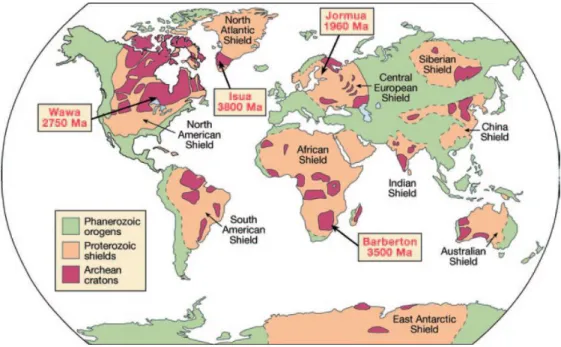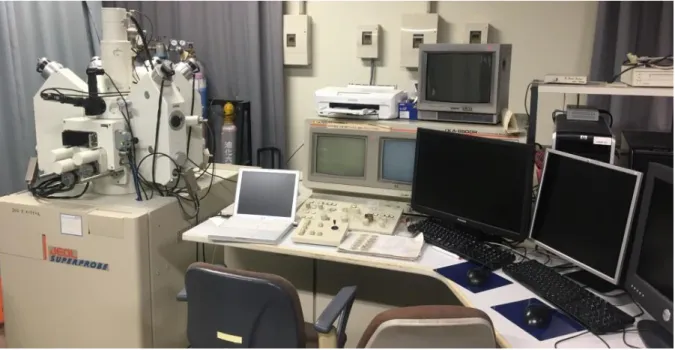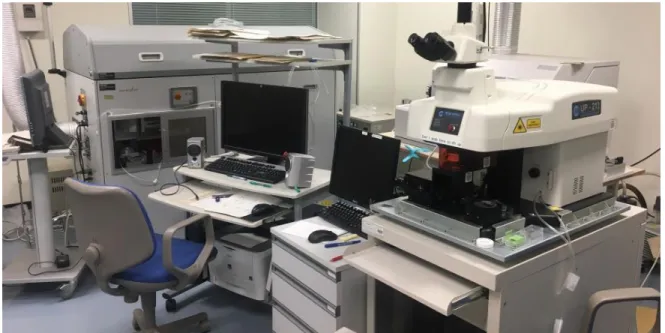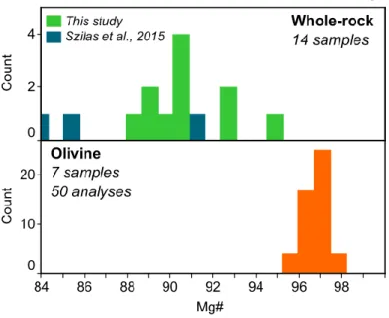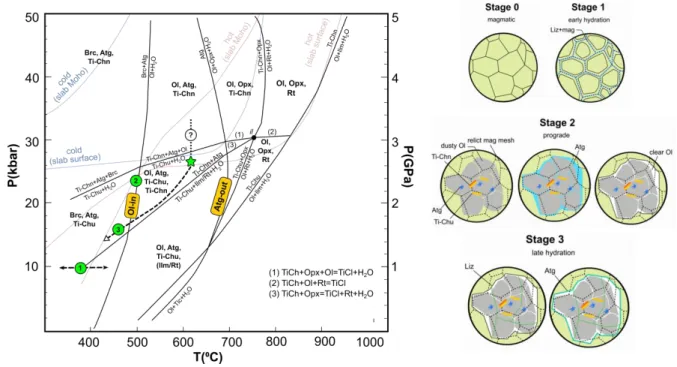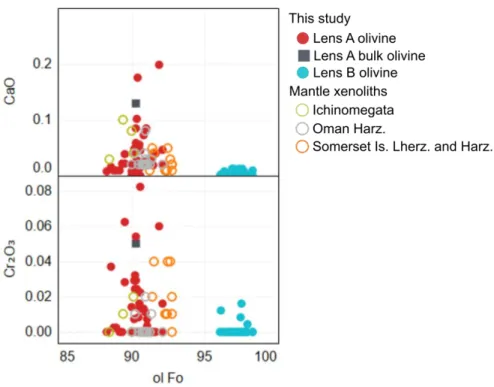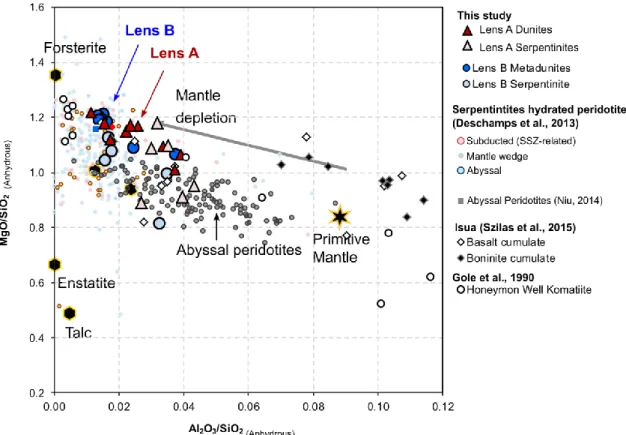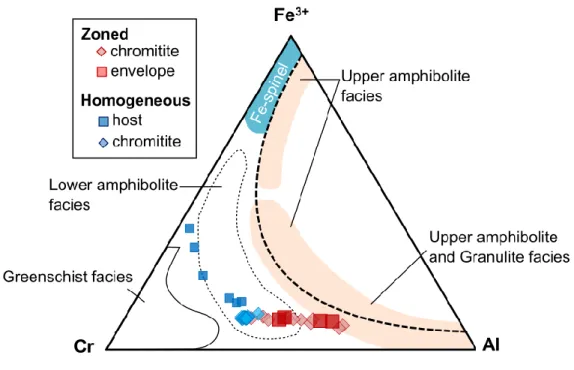Petrology and metamorphic evolution of the ultramafic rocks in the Eoarchean Isua
supracrustal belt: Implications to Archean geodynamics
著者 グオタナ ジュアン ミゲル ラミレズ
著者別表示 GUOTANA JUAN MIGUEL RAMIREZ journal or
publication title
博士論文本文Full 学位授与番号 13301甲第1934号
学位名 博士(学術)
学位授与年月日 2020‑09‑28
URL http://hdl.handle.net/2297/00061375
doi: https://doi.org/10.3390/geosciences8090328
Creative Commons : 表示 ‑ 非営利 ‑ 改変禁止 http://creativecommons.org/licenses/by‑nc‑nd/3.0/deed.ja
Dissertation
Petrology and metamorphic evolution of the ultramafic rocks in the Eoarchean Isua supracrustal belt:
Implications to Archean geodynamics
Graduate School of
Natural Science & Technology Kanazawa University
Division of Natural System
Student ID: 1724062014
Name: Juan Miguel Ramirez GUOTANA Chief Supervisor: Prof. Tomoaki Morishita
June 2020
2 TABLE OF CONTENTS
List of Figures --- 4
Abstract --- 5
1 Introduction --- 8
1.1 The Early Earth: Geodynamics and Archean geologic records --- 8
1.2 Archean subduction fingerprinting --- 9
1.3 Ultramafic rocks in Isua Supracrustal Belt --- 11
1.4 Metamorphism in ISB --- 12
1.5 Motivation and objectives --- 13
2 Geology --- 14
2.2 Geologic Setting --- 14
2.3 ISB ultramafic --- 16
2.4 Sample Locality --- 17
3 Analytical methods --- 18
3.1 Petrography --- 18
3.2 Electron Probe Microanalysis --- 18
3.3 Laser-ablation ICP-MS --- --- 19
3.4 Raman spectroscopy --- 19
3.5 Whole-rock XRF --- 20
4 Deserpentinization and high pressure (eclogite-facies) metamorphic features in ISB Lens B --- 21
4.1 Metamorphism of ultramafic rocks --- 21
4.1.1. Serpentinization --- 21
4.1.2. Carbonation --- 24
4.1.3. Deserpentinization --- 25
4.2 Humite-group of minerals as thermobarometric indicator --- 25
4.3 Lens B sample description --- 26
4.4 Results --- 31
4.4.1. Major-element mineral chemistry --- 31
4.4.2. Trace-element mineral chemistry --- 33
4.5. Discussion --- 36
4.5.1 Secondary olivine and deserpentinization imprints --- 36
4.5.2. Ti-Chu and Ti-Chn as high-pressure metamorphism marker in the ISB Lens B metadunites --- 37
4.6. Metamorphic history --- 38
4.6.1. Early serpentinization --- 38
4.6.2. Prograde metamorphism --- 38
4.6.3. Later retrograde stage --- 39
3
4.7. Timing of HP metamorphism --- 39
4.8. Implications for Archean metamorphism --- 39
4.9. Summary --- 41
5 Symplectite exsolutions within Lens A olivine --- 5.1. Mechanisms of formation of symplectites in olivine --- 42
5.1.1. Dehydrogenation and oxidation model --- 43
5.2. Sample description --- 44
5.3. Mineral chemistry --- 46
5.4. Discussion --- 46
5.4.1. Comparison with Lens B, more igneous features --- 46
5.4.2. Symplectite formation in Lens A olivine --- 49
5.5. Summary --- 50
6 Complex metamorphic imprints in other ultramafic bodies in southern West Greenland: Metamorphism in Ulamertoq peridotite body --- 52
6.1. Geological setting --- 52
6.2. Zoned and homogeneous chromites --- 52
6.3. Discussion --- 58
6.3.1. Mechanism for zone chromites formation --- 58
6.3.2. Metamorphic imprints and P-T path --- 58
7 Conclusions --- 59
8 Acknowledgements --- 60
9 References --- 60
10 Tables --- 76
4 LIST OF FIGURES AND TABLES
Figure 1 The evolution of geodynamic models of the Earth--- 9
Figure 2 Global map showing the distribution of Precambrian shields and cratons --- 10
Figure 3 Generalized geologic map of the Isua supracrustal belt and surround Itsaq gneiss complex--- 15
Figure 4 Detailed map of the western limb of the ISB--- 17
Figure 5 Jeol-JXA 8800 Electron probe micronalayzer--- 18
Figure 6 Laser-ablation ICP-MS at Kanazawa University --- 19
Figure 7 Raman spectrometer at Kanazawa University--- 20
Figure 8 Map showing the location of Lens B in the western limb of the Isua supracrustal belt, geologic and sampling location map of Lens B--- 22
Figure 9 Phase diagram showing the stability fields of chrysotile, lizardite and antigorite--- 24
Figure 10 Photomicrographs showing various olivine textures--- 27
Figure 11 Photomicrographs showing various antigorite textures--- 28
Figure 12 Photomicrographs showing various Ti-rich humite group of minerals textures--- 29
Figure 13 Photomicrographs showing accessory phases (carbonates, hydrotalcite and sulfide) --- 30
Figure 14 Raman spectra of humite- group minerals and serpentine in the ISB metadunites --- 31
Figure 15 Olivine Mg# versus NiO wt% and MnO wt% of the ISB Lens B--- 32
Figure 16 Histogram showing the comparison of whole-rock--- 32
Figure 17 Major-element variation diagrams of humites in the ISB Lens B--- 34
Figure 18 Chondrite and Primitive mantle normalized REE and multi-element patterns of Lens B olivine --- 35
Figure 19 Fluid mobile elements (Li, B and Pb) concentrations of Lens B olivine --- 36
Figure 20 P-T diagram of Ti-Chn and Ti-Chu showing the metamorphic P-T path of ISB Lens B metadunites--- 40
Figure 21 Map showing the location of Lens A in the western limb of the Isua supracrustal belt and sampling location map--- 43
Figure 22 Dehydrogenation and oxidation model in olivine--- 45
Figure 23 Representative photomicrographs of Lens A dunitic rocks--- 45
Figure 24 Olivine Mg# versus MnO wt.% and NiO wt% of Lens A samples---- 47
Figure 25 Fo content plotted against CaO and Cr2O3 of olivine in the Lens A dunitic samples compared to mantle xenolith olivine from other areas --- 48
Figure 26 Cr-Fe3+-Al ternary plot for the Lens A spinel composition--- 48
Figure 27 MgO/SiO2 plotted against Al2O3/SiO2 (calculated volatile- free) of ISB ultramafic rocks compared from other serpentinites (and hydrated peridotites) from various tectonic settings compiled--- 49
Figure 28 Simplified geologic map of southern West Greenland showing the Akia, Akulleq, and Tarsiusarsuaq terranes and map showing the ultramafic bodies within the Mesoarchaean orthogneiss in Akia terrane--- 53
Figure 29 Representative photomicrographs of Ulamertoq samples--- 54 Figure 30 Backscattered scanning electron microscope (SEM) images and 55
5 compositional maps of zoned chromites from the Ulamertoq
peridotite body--- Figure 31 Olivine forsterite content vs. NiO wt.% and MnO wt. % plot of the
Ulamertoq samples--- 56 Figure 32 Cr–Fe3+–Al ternary plot of the Ulamertoq chromites plotted with
fields of metamorphic spinels from different metamorphic grades---- 56 Figure 33 CaO-MgO-SiO2-H2O phase equilibria of ultramafic rocks with the
stability field of the zoned and homogenous --- 57 Table 1 Major-element mineral chemistry of olivine from the Lens B
metadunites---
77 Table 2 Trace-element mineral chemistry of olivine from the Lens B
metadunites---
82 Table 3 Major-element mineral chemistry of antigorites from the Lens B
metadunites---
83 Table 4 Major-element mineral chemistry of lizardites from the Lens B
metadunites---
87 Table 5 Major-element mineral chemistry of titanian chondrodite (Ti-Chn)
and titanian clinohumite (Ti-Chu) from the Lens B metadunites---
90 Table 6 Major-element mineral chemistry of spinels from the Lens B
metadunites---
92 Table 7
Major-element mineral chemistry of magnesite and stichtite from
93 Table 8 Major-element mineral chemistry of spinel from Lens A dunitic
rocks---
94 Table 9 Major-element mineral chemistry of olivine from Lens A dunitic
rocks---
96 Table 10 Major-element mineral chemistry of clinopyroxene from Lens A
dunitic rocks---
99 Table 11 Whole-rock major-element geochemistry (anhydrous) of Lens B
samples determined by XRF---
100 Table 12 Whole-rock trace-element geochemistry of Lens B samples
determined by XRF---
100
6 ABSTRACT
The Archean Eon marks the onset of the cooling of the Earth. It was during the Archean Eon that crust started strengthening of the crust, ocean formed, transition to plate tectonics and emergence of life. The early Earth associated mantle and lithosphere still remain enigmatic due to limited preserved intact geological records. Contemporary plate tectonics could not have operated in the past due to the higher mantle temperature. It has been challenging to discover the most intact pieces of the early Earth preserved today for geodynamic reconstructions. Precambrian rocks some of which are dated as Archean are exposed in Greenland and form part of the North Atlantic Craton (NAC). The main exposure of the NAC is along the SW portion of Greenland which consists of Eo- to Neoarchean orthogneiss which includes the Eoarchean Itsaq gneiss complex. The Isua supracrustal belt (ISB), located within the Itsaq gneiss complex, is a fragment of sedimentary and volcanic succession intruded by tonalities and granites. Ultramafic rocks occur as discontinuous enclaves within the supracrustal assemblage. The affinity of the ultramafic rocks is still unclear. The ultramafic bodies in the western limb of ISB (Lens A and Lens B) that were interpreted to have lesser effects of metamorphism and deformation are the focus of this study. In Lens B, Ti-rich humite-type minerals (nM2SiO4·M1-x(OH,F)2-2xTixO2x) such as titanian chondrodite (Ti-Chn) and titanian clinohumite (Ti-Chu) occur as accessory phases in these ultramafic rock bodies forming patches within olivine. The host olivine contains abundant magnetite inclusions. The high forsterite content (Fo=96-98) and variable MnO and NiO of the host olivine indicate a metamorphic origin as a result of deserpentinization rather than primary igneous features. Recent experimental works suggest a 2.6 GPa pressure stability condition for Ti-Chn co-existing with olivine. The intergrowth relationship between Ti-Chn and Ti-Chu formed as a result of breakdown during decompression. The discrete Ti- Chu grains suggest a retrograde path from high-pressure (2.6 GPa) to lower pressure (1 GPa) within the antigorite stability field (630-660°C). The overall petrological and geochemical features of the 3.8-3.7 Ga ISB Lens B ultramafic rocks reached eclogite facies conditions following deserpentinization. The exact timing of the high-pressure metamorphic event is not clear. However, the high-pressure metamorphic imprints are not reflected in the surrounding amphibolites. It suggests that the high pressure metamorphism occurred younger than the previously established metamorphic events (3.74 and 2.87 Ga) characterized by temperatures above 610°C, 480 to 550°C and a minimum pressure of 6 kbar due to the presence of kayanite in the domain where the ultramafic lenses are exposed.
7 The southern Lens A (south of Lens B) exhibits contrasting textural and geochemical signatures (Fo=89-92 and less varying MnO and NiO contents) suggesting weaker metamorphic imprints. The formation of spinel-clinopyroxene symplectites in olivine in Lens A can be explained by subsolidus elemental diffusion form host olivine or by dehydrogenation-oxidation of hydrous olivine and possibly humite layers in olivine.
The Eoarchean Lens B metadunites exhibit features suggestive of HP metamorphism followed by retrograde metamorphism, which are petrological features that can be explained by deep burial followed by rapid exhumation, comparable to modern subduction zone channels, though the extent of actual subduction remains enigmatic. On the contrary, Lens A shows minimal metamorphic imprints and more igneous features. Studies on primary igneous features of ultramafic rocks can be more focused on Lens A. The contrast observed between the two lenses difference in composition and texture compared to Lens B suggesting difference in the P-T path or exhumation history.
8 1. INTRODUCTION
1.1.The Early Earth: Geodynamics and Archean geologic records
The Earth started cooling during the Archean Eon (4.6 Billion to 2.5 Million years ago) which lead to the strengthening of the crust, formation of oceans, plate tectonics and emergence of life (Wilde et al., 2001; Smithies et al., 2003; Dilek and Furnes, 2013; Noffke et al., 2013). The early Earth associated mantle and lithosphere still remain cryptic due to the paucity of intact geologic records that are free from deformation and chemical modification.
Modern-style plate tectonics could not have operated in the past due to the higher mantle temperature (Hadean-Archean: ~200-250°C; Archean-Proterozoic: ~100-200°C) (Nisbet and Fowler, 1983; Abbott et al., 1994; Sizova et al., 2010). Early Earth geodynamics is characterized by “squishy lid” tectonics (Hadean-Archean) and a transition phase (Archean to Proterozoic) before modern-style plate tectonics (Gerya, 2019). The challenge lies in discovering and validating the oldest geologic clues to reconstruct the early Earth geodynamics. In searching for such clues, certain areas in the world preserve the oldest geologic records and have been the subject of interest (Fig. 1).
The mantle during the Hadean-Archean eon (ca. 3 Ga) was about 200-250°C higher than present-day temperature. The lithosphere was mainly formed by tectonomagmatic differentiation (Sizova et al., 2010). Unstable portions of the crust are removed by eclogite dripping and delamination. Recycling of lithosphere is mainly driven by plume- and impact- induced delamination/subduction (Gerya et al., 2015). The period from Hadean-Archean is characterized by a period of crust and lithosphere growth followed by a removal phase due to the weak nature of the lithosphere and high mantle temperature (squishy-lid tectonics) (Gerya, 2019). Transitional tectonics is proposed to have occurred during the Archean- Proterozoic (3Ga-1Ga) wherein squishy-lid tectonics evolved developed towards plate- tectonic-like. The mantle is still hotter (100-200°C) than present-day and plume-induced subduction was most likely common (Fischer and Gerya, 2016). Modern-style plate tectonics operated at ca. 1-0.5 Ga as a result of the cooling mantle, mosaic of rigid plates, the rise of continents and increased erosion that provided lubrication along trenches for subduction (Sobolev and Brown, 2019).
9 Figure 1. The evolution of geodynamic models of the Earth (top) and a graph showing the depth and age relationship of available data in constraining the models (adopted from Gerya, 2019).
1.2. Archean subduction fingerprinting
Plate tectonics is the horizontal movement of the stabilized lithospheric plates over a convecting mantle towards subduction zones wherein it sinks back to the mantle (Wilson, 1965; Cox, 1986; Stern, 2007). Subduction provides force in driving plate tectonics from the gravitational pull of the dense slabs (Forsyth and Uyeda, 1975). The formation of continental crust and recycling crustal materials to the mantle is attributed to subduction which contributes to the compositional structure of the Earth (Hawkesworth et al., 1993; Davidson and Arculus, 2006; Rupke et al., 2004; Herman and Spandler, 2008).
The onset of plate tectonics has been the focus of several studies. Plate tectonics and subduction zone processes documented in the oldest rock records from the Archean are interpreted based on the features related to modern analogs (Stern, 2007). Subduction zone markers can be classified into geochemical, metamorphic and structural markers.
Geochemical markers are from igneous rocks with arc signature (e.g. Miyashiro, 1974;
10 Tatsumi, 2005). The presence of high-pressure metamorphic rocks such as blueschist to eclogite facies rocks and paired metamorphic belt are considered as metamorphic subduction zone markers (Dewey and Bird, 1970; Miyashiro, 1972). The structural marker includes accretionary wedges and associated thrust planes (Coney et al., 1980). These features are recognized from Archean records; however, there is still an ongoing discussion on how to interpret such features.
In looking for subduction clues, preserved Archean cratons and shields have been explored. The oldest known Earth materials are minerals which were the basis of the isotopic age delineating the Archean Eon. Zircon grains which yielded isotopic age of 4.2-4.4 Ga (Jack Hills zircons) were found in sedimentary rocks in Western Australia (Harrison et al., 2005). The oldest known rock on Earth is the volcanic deposits metamorphosed to amphibolite facies that forms part of the Nuvvuagittuq greenstone belt in Quebec, Canada (4.28 billion-year-old) (O’Neil et al., 2008). The Acasta gneiss in northwestern Canada preserves a single relict zircon grain yielding 4.0 Ga age and the second oldest (Bowring et al., 1989). Greenland also preserves a 3.85 Ga volcanic-sedimentary lithologic package interpreted to be an ancient accretionary wedge (Nutman et al., 1996a).
Figure 2. Global map showing the distribution of Precambrian shields and cratons (map adopted from Marshak, 2005).
11 1.3. Ultramafic rocks in Isua Supracrustal Belt
Archean crust (exposed and buried) constitutes an area of about 15,476,000 km2 which is about 15% of the preserved Precambrian crust (Goodwin, 1991) (Fig. 2). A complex and multiple suturing events built the Archean and Proterozoic cratons forming a continental lithosphere in Canada, Greenland and NW Europe (Balling, 2000). Precambrian rocks some of which are dated as Archean are exposed in Greenland and form part of the North Atlantic Craton (NAC). The main exposure of the NAC is along the SW portion of Greenland which consists of Eo- to Neoarchean orthogneiss which includes the Eoarchean Itsaq Gneiss complex (Nutman et al., 1996a). The Itsaq gneiss complex forms part of the Akulleq Terrane (3880–3660 Ma) in southern West Greenland. The Akia Terrane (3230–2980 Ma) and the Tasiusarsuaq (2920–2830 Ma) bound the Akulleq Terrane from north to south (Mcgregor et al., 1991; Nutman et al., 1996a). The Eoarchean Isua supracrustal belt is composed of igneous and sedimentary lithologic packages that are interpreted to have retained low strain and low alteration zones that are primary features (see summary in Nutman et al., 1996b, 2020; Complex et al., 1999) despite polyphase metamorphism and deformation (Boak and Dymek, 1982; Rose et al., 1996).
The Isua supracrustal belt (ISB) is a 35-km arcuate belt located within the Eoarchean terranes which are composed of 3.9-3.6 Ga Amıtsoq gneiss and 2.8 Ga Ikkattoq gneiss. In some areas, low-strain and alteration-free pillow lavas are exposed suggesting that original lithological relationship and chemical features can still be observed in the ISB (Appel et al., 1998). Several trains of discontinuous ultramafic bodies are exposed within the ISB and the origin of these ultramafic rocks is still enigmatic with varying interpretations. The ISB ultramafic rocks have been interpreted as metamorphosed olivine+pyroxene protoliths from the mantle (Friend and Nutman, 2011), cumulates (Szilas et al., 2015) or layered intrusion (Rollinson, 2007). The ultramafic bodies that show the least deformation and chemical modification are exposed in the eastern portion of the western limb of the ISB. These bodies are referred to as Lens A and Lens B (Fig. 3) by Friend and Nutman (2011). The exact origin of the ultramafic bodies has been interpreted in various ways.
Almost all of the lithologies in the ISB are affected by pervasive metasomatism which heavily imprinted the protoliths (Rosing, 1989; Rose et al., 1996). In this study, detailed examination of the metamorphic features and P-T paths of these rocks are investigated which could provide clues on its origin.
12 1.4. Metamorphism in ISB
Several metamorphic studies done in ISB focused on the surrounding metabasites and metapelites (Boak and Dymek, 1982; Komiya et al., 2002). The detailed study of the garnet morphology and composition suggest several growth generations. The eastern part of the western limb of the ISB falls under Domain IV. Several domains in the ISB (Domains II-V) record two garnet growths which correspond to metamorphic events (average age 3.74 Ga).
Two domains (Domain II and IV) record a younger garnet growth. The younger garnet is linked to the 2.8 Ga metamorphic event (Gruau et al., 1996; Frei et al., 1999) which is both recorded in Domains III and IV also. Garnet-biotite pairs suggest that temperature conditions of above 610°C for the early metamorphic event (3.74 Ga) and a lower temperature range (550-570°C) for the younger metamorphic event (2.8 Ga). The pressure for the earlier metamorphism is constrained by the presence of kyanite in the sample which is around 6 kbar (Rollinson, 2002b).
Metamorphosed ultramafic rocks were reported and described by Dymek et al. (1988) from the southern train of the western limb of ISB. This study focuses on the metamorphic features and history of the ultramafic bodies (Lens A and B) on the northeastern portion of the western ISB.
Low-grade metamorphism of ultramafic rocks is typically dominated by serpentine minerals: lizardite, chrysotile and antigorite. Serpentine minerals replace olivine and pyroxene in the ultramafic rocks. The breakdown of serpentine at higher temperatures is marked by the appearance of secondary olivine, pyroxene and amphibole (Spear, 1993). The prograde assemblage is recognized by slight textural and compositional differences from the primary assemblage. Spinel, though regarded as resistant, also record metamorphism at various metamorphic grade (Barnes and Roeder, 2001). The dehydration of serpentine is also referred to as deserpentinization. Fluids released during deserpentinization also enhance the metamorphic reaction. Ultramafic rocks in the MgO-SiO2-H2O system have limited thermobarometric indicators. Accessory phases such as titanium-rich humite group of minerals have been recently described in detail in terms of PT stability (Shen et al., 2015). In the absence of garnet, such phases are very useful in reconstructing the PT history of ultramafic rocks.
13 1.5. Motivation and objectives
The origin of the ultramafic rocks in ISB has been a controversial topic on petrological studies in the ISB. This study focuses on the petrological and chemical features of the ultramafic rocks in ISB emphasizing on the metamorphism recorded by these rocks.
Unraveling the metamorphic imprints will give clues on the possible magmatic features that will help resolve the origin of the IBS ultramafic rocks. This study specifically aims to:
Characterize the ultramafic bodies in the western ISB
Compare the petrologic and chemical composition of these ultramafic bodies
Investigate the effects of deserpentinization
Reconstruct the metamorphic PT path of the ISB ultramafic rocks
Elucidate its implications in Archean metamorphism and tectonics
14 2. GEOLOGY
2.1. Geologic Setting
The Isua supracrustal (ISB) belt is a 35-km arcuate belt located within the Akulleq terrane which is composed of 3.88–3.66 Ga Amıtsoq gneiss and 2.82 Ga Ikkattoq gneiss. The Isua supracrustal belt is subdivided into two terranes, an older 3.8Ga southern terrane and a younger 3.7 Ga northern terrane (Fig. 3). The two terranes are separated by a tectonic divide made up of felsic schist with zircon age of 3.94-3.74 Ga (Nutman and Friend, 2009). The terranes were assembled before 3660 Ma marked by the intrusion of the Inaluk dikes (Nutman and Friend, 2009). The ISB preserves one of the oldest submarine igneous sequences in the world. The ISB and surrounding supracrustal rocks (Akilia association) are intruded by the Amitsoq gneiss which forms part of the Itsaq gneiss complex (McGregor and Mason, 1977; Baadsgaard et al., 1984; Nutman et al., 1984; Harland et al., 1990). Some rocks in the Isua supracrustal belt preserve primary features which include basaltic extrusive and hypabyssal rocks associated with banded iron formation (BIF), chemical and clastic sediments. Well preserved sheeted dikes intruding the amphibolite+ultramafic rocks in the western limb of the ISB was reported by (Furnes et al., 2007). The ultramafic rocks in ISB can be generally classified into metadunite and metaperidotites and could be mantle residues, sills or cumulates. However, the exact affinity is still unclear. Felsic rocks are mainly granitoid intrusions but also include detrital sediments and volcaniclastic flows that are petrographically and geochemically similar to the surrounding Amitsoq gneiss. The Amitsoq gneiss also occurs as tectonically intercalated sheets with other supracrustal rocks in ISB (Furnes et al., 2009).
The ISB can also be subdivided into two units: 1) Undifferentiated amphibolites (UA) and 2) Garbenschiefer amphibolites (GA). The undifferentiated amphibolites preserve associated lithologies and structures that resemble an ophiolitic suite such as pillow lava, subparallel dikes, plagiogranite, gabbro and ultramafic rocks (Maruyama, 1991; Komiya et al., 1999; Furnes et al., 2007; Nutman et al., 2009). The Garbenschiefer amphibolites are mostly amphibole-garnet-biotite-chlorite schists with protoliths including volcanic and sedimentary rocks (Frei et al., 1999; Furnes et al., 2007). The geochemical signature of UA is comparable to igneous rocks with mid-ocean ridge basalt (MORB)-like composition with weak subduction imprint (elevated Th/Yb and Nb anomalies). The GA exhibits major and
15 Figure3. Generalized geologicmap ofthe Isuasupracrustalbelt and surrounding Itsaq gneisscomplex(map modified from Nutmanand Friend, 2009).
16 trace-element composition similar to boninitic to island-arc tholeiite (IAT) magmatic rocks of SSZ-type ophiolites (Polat et al., 2002; Furnes et al., 2007).
2.3. ISB ultramafic rocks
Ultramafic rocks are exposed both in the eastern and western parts of the ISB. Most of the studies on the ultramafic rocks in ISB focused on the western limb in low-strain areas.
The ISB ultramafic rocks have been interpreted as metamorphosed olivine+pyroxene protoliths from cumulates or sills mostly based on the ca. 3.80 Ga package of the western limb. In the southern portion of the western limb, olivine grains (Fo85-97) are commonly intergrown with titanian clinohumite (Ti-Chu) and titanian chondrodite (Ti-Chn) (Dymek et al., 1988).
In the northeastern part of the western ISB limb, several ultramafic bodies that exhibit the least effects of chemical modification and deformation are exposed. These ultramafic bodies are referred to as Lens A and B (Friend and Nutman, 2011) (Fig. 4). The dunitic lenses are hosted within deformed, hydrated, carbonated ultramafic schists with fabrics comparable to the surrounding amphibolites (Friend and Nutman, 2011). The more intact dunite cores preserve structures that are oblique to the surrounding schists and mafic rocks. Lens A is the southern ultramafic body consists mainly of olivine (Fo91-92), serpentine, chlorite and spinel.
Lens B, in the northern part, has more complex assemblage with reported primary orthopyroxenes, secondary chlorite and humite group of minerals intergrown with olivine (Fo96-98).
The origin of these ultramafic rocks has been the focus of previous studies (Rollinson, 2007; Friend and Nutman, 2011; Szilas et al., 2015; Kaczmarek et al., 2016). It was proposed that these are subarc mantle residues that are associated which are directly linked with the formation of the surrounding arc rocks. The HFSE depletion in the surrounding arc rocks is ascribed to the humite group of minerals HFSE enrichment (Friend and Nutman, 2011). B- type olivine fabric is also present in the ultramafic samples which are linked to mantle and suprasubdcution mantle wedge setting wherein such fabric can be found (Kaczmarek et al., 2016). The geochemistry and platinum-group of element composition of the ultramafic rocks show a correlation with the surrounding rocks and are akin to cumulate ultramafic rocks.
These ultramafic rocks are also interpreted as cumulate equivalents of the surrounding boninites and basaltic rocks (Szilas et al., 2015). Spinel chemistry from some ultramafic samples is also comparable to the layered intrusion in the south of ISB (Rollinson, 2007).
17 Figure 4. Detailed map of the western limb of the ISB showing the ultramafic lenses and surrounding metamorphosed mafic rocks modified from Friend and Nutman, 2011; Szilas et al., 2015.
2.4. Sample Locality
The samples in this study were collected in the northwestern limb of the ISB (Fig. 4), from the dunitic Lens B described by Friend and Nutman (2011). This ca. 130 x 680m dunite body exhibits varying degrees of serpentinization and is rimmed by talc-carbonate schist. The samples of this study will be referred to as metadunites hereafter due to the metamorphic origin of these rocks, which will be discussed in the following sections. Further south, Ti-Chn and Ti-Chu-bearing metadunite has also been reported, sharing general similar characteristics with the samples from and Lens B (Dymek et al., 1988).
Lens B
Lens A
18 3. ANALYTICAL METHODS
3.1. Petrography
Thin sections of representative samples from ISB Lens A and Lens B were prepared.
Rock slabs from the hand specimen were cut. Lapping and polishing of rock slabs was done using 200, 400, 800, 1000 and 3000 SiC powder grits and the finally with a 1 µm diamond polishing solution. A Nikon Eclipse LV100 Pol polarizing petrographic microscope was used in the detailed observation of the thin sections.
3.2. Electron Probe Microanalysis
The major-element compositions of mineral phases were obtained using a JEOL JXA- 8800 electron probe microanalyzer (EPMA) at the Kanazawa University (Fig. 5). The analyses were carried out using operating conditions of 20 kV accelerating voltage, 20 nA beam current, and a 3 µm beam diameter. The X-ray peaks and backgrounds of elements were analyzed for 20 and 10 seconds, respectively; except for Ni (30 and 15 seconds) Natural and synthetic standards were used for the analysis and results were corrected using ZAF (Z=atomic number, A=absorption, F=characteristic fluorescence) correction method using JEOL JXA-8800 software. Summary of major element compositions are presented in Tables 1, 3-10.
Figure 5. Jeol-JXA 8800 Electron probe micronalayzer at Kanazawa University.
19 3.3. Laser-ablation ICP-MS
A Laser Ablation Inductively Coupled Plasma Mass Spectrometry (LA-ICP-MS) (Agilent 7500S equipped with MicroLas Geolas Q-plus laser system; Agilent Technologies, Santa Clara, CA, US) at the Kanazawa University was used to analyze the concentrations of rare earth element (REE) and trace element compositions of major and minor phases (Fig. 6).
An ablating spot size of 50 μm in diameter at a repetition rate of 6 Hz was used in each analysis point. External reference material was NIST SRM 612 and data reduction was facilitated using 29Si as the internal standard, using the SiO2 content obtained by EPMA.
Summary of trace element composition is presented in Table 2.
Figure 6. Laser-ablation ICP-MS (Agilent 7500S equipped with MicroLas Geolas Q-plus laser system) at Kanazawa University.
3.4. Raman spectroscopy
The serpentine minerals were identified using micro-Raman system (HORIBA Jobin Yvon, LabRam HR800) equipped with a 532 nm Nd:YAG laser (Showa Optronics Co., Ltd, J100GS-16) and an Olympus BX41 optical microscope at the Kanazawa University.
20 Figure 7. Raman spectrometer at Kanazawa University (HORIBA Jobin Yvon, LabRam HR800).
3.5. Whole-rock XRF
The whole-rock compositions of representative Lens A and B metadunites were determined at the National Museum of Nature and Science in Tsukuba, Japan. The weathered and altered portions of the samples were removed and rocks slabs were made from representative samples (5x5x1cm). The rock slabs were subjected to grinding (200 grit size) to remove metal contamination induced by rock saw blades. The samples were washed using deionized water during a sonic bath and dried inside an oven. Each sample was coarsely crushed using a plastic hammer over a granite slab while wrapped with a thick plastic and kim towel to avoid contamination. The crushed samples were washed with deionized water and finally with acetone before drying in an oven overnight. The dried crushed samples were finely crushed using an alumina mortar and pestle. The finely crushed samples were powdered with a rapid pulverizer multi-beads shocker. The loss on ignition (L.O.I) values were determination was carried out by igniting 0.4000+0.0004 g of powdered samples at 1025ºC for 4 hours. The difference with the weight prior and after ignition determines the L.O.I. Glass beads were prepared containing lithium tetraborate flux (10 to 1 sample dilution). Pressed pellets (4.0-5.0g) were prepared using a 12-ton force for trace element geochemistry. The major and trace element compositions were measured using an X-ray fluorescence spectrometer (RIGAKU ZSX Primus II) following a method described in (Sano et al., 2011).
21 4. DESERPENTINIZATION AND HIGH PRESSURE (ECLOGITE-FACIES)
METAMORPHIC FEATURES IN ISB LENS B
Lens B belongs to the few ultramafic lenses in the northeastern part of western ISB which are interpreted to have retained primary magmatic features (Friend and Nutman, 2011;
Kaczmarek et al., 2016). The core of the ultramafic body Lens B is characterized by weakly altered dunite with a highly serpentinized outer body (Fig. 8). Ultramafic schist envelopes the dunitic lens. Lens B contains titanian chondrodite (Ti-Chn) and titanian clinohumite (Ti- Chu) as accessory phases. In this chapter, the metamorphic imprints on Lens B are discussed.
The occurrence of humite group of minerals and the textural and chemical features of other phases suggest that Lens B reached high-pressure metamorphic conditions and several hydration and dehydration events.
4.1. Metamorphism of ultramafic rocks
Ultramafic rocks (>90% mafic minerals) occur mostly in the mantle and have been continuously subjected to melting, metasomatism and recycling which subsequently diversifies its composition (Downes, 2020). Ultramafic rocks exposed or brought to the surface could have originated as mantle residues after partial melting, cumulates, komatiitic volcanics or its derivatives.
The emplacement of ultramafic rocks in the crust involves mineralogical modification and deformation. The metamorphism upon emplacement could either form allofacial or isofacial ultramafic rocks. Allofacial ultramafic rocks may preserve original structure and mineralogy and due to slow equilibration, it may not or only partly reflect assemblage of the same metamorphic grade with the surrounding rocks (ophiolite complexes). Isofacial ultramafic rocks record P-T histories similar to the crustal host lithologies and may preserve minimal relic phases or structures (Evans, 1977; Bucher and Frey, 2002).
4.1.1. Serpentinization
Serpentinization is a hydrothermal alteration of low silica ultramafic rocks at a relatively low-temperature condition (<500°C). Hydration of olivine and pyroxene forms serpentine+brucite+magnetite. The process of serpentinization takes effect in various geologic settings: ocean floor, mid-ocean ridges and subduction zones (Evans, 2010).
22 Figure 8. A) Map showing the location of Lens B in the western limb of the Isua supracrustal belt. B) Geologic map of Lens B from Friend and Nutman, 2011. C) Map showing the sampling locations in Lens B (Aerial image from Google Earth).
The hydration process of ultramafic rocks may uptake H2O up to 13 wt. % (Ulmer and Trommsdorff, 1995).
Serpentinization is also responsible in introducing fluid mobile elements (FMEs) such as B, Sr and Cs Cs (Hattori and Guillot, 2003; Scambelluri et al., 2004). The stability of serpentine at higher pressure and depth (150 km) has been described by recent studies, thus, an important phase in transporting fluid and FMEs back to the mantle (Ulmer and Trommsdorff, 1995). Serpentine occurs in different types but more commonly as chrysotile, lizardite and antigorite. The identification of serpentine species is achieved by Raman spectroscopy or transmission electron microscopy but the minor chemical difference can also be observed. In the MHS system, serpentinization generally occurs in the following process:
2Mg2SiO4+3H2OMg3Si2O5(OH)4+Mg(OH)2
(Forsterite) (Serpentine) (Brucite)
Serpentinization involves oxidation of iron, the formation of magnetite and the release of H+. The formation of magnetite is more effective in the latter part of serpentinization and
23 relatively higher temperatures. At T~200°C, serpentinization produces Fe-rich brucite coupled with fewer magnetites. Samples serpentinized at temperatures between 200-300°C contain abundant magnetite. In both cases, H2 is efficiently due to iron oxidation in serpentine (Klein et al., 2014). The release of H2 is also an important part of serpentinization. The oxidation of Fe2+ to Fe3+ in olivine produces molecular hydrogen. The ferric iron is taken up by magnetite and other secondary silicate minerals such as serpentine, talc and tremolite (Evans, 2010). The formation of magnetite is more associated with the later stage of serpentinization after the breakdown of Fe-rich brucite (Bach et al., 2006).
Serpentine minerals have a general formula of (Mg, Fe2+)3Si2O5(OH)4. The stability field of serpentinites is generally challenging to evaluate due to the wide stability field (Evans, 2004). The three main serpentine types are lizardite, chrysotile and antigorite.
Antigorite persists at higher-grade metamorphism and experimental works verify its stability at higher pressure conditions (Evans and Trommsdorff, 1978; Scambelluri et al., 1995;
Padrón-Navarta et al., 2013; Debret et al., 2013b). Lizardite and chrysotile are more stable at lower grade metamorphism (Evans, 2004; Andréani et al., 2007). The assemblage antigorite+brucite is more stable than lizardite+chrysotile above 300°C during the transition from low- to high-grade metamorphism based on thermodynamic factors (Schwartz et al., 2013). In identifying specific serpentine varieties, transmission electron microscopy (TEM) and Raman spectroscopy are highly effective. The OH band obtained through Raman spectroscopy has been used to identify serpentine varieties.
There are several models in the stability fields of serpentine varieties (O’Hanley, 1996; Evans, 2004; Schwartz et al., 2013). The work of Schwartz et al., (2013) evaluated the PT stability of the serpentine bearing natural samples. The temperature stability is also constrained based on the surrounding/host metasediments which correlate to the serpentine varieties stable from low- to high temperature. The results of their work show that antigorite is absent at low-grade metamorphism in the sub-greenschist facies (P<0.4GPa, T- 200- 300°C). The replacement of lizardite by antigorite occurs around 320°C starting from the lizardite grain boundaries and along with cores. The mesh-texture during replacement is typically preserved. Lizardite+antigorite are stable between 320-390°C (Fig.9). The addition of SiO2 to lizardite and chrysotile also promotes antigorite stability (e.g. Evans, 2004).
24 Figure 9. Phase diagram (after Schwartz et al., 2013) showing the stability fields of chrysotile, lizardite and antigorite (Evans, 2004). The univariant curve of serpentine dehydration is around 500°C.
4.1.2. Carbonation
CO2 metasomatism of ultramafic rocks also forms carbonates and Fe-talc. The carbonation products are a function of the protolith composition, fluid CO2 activity and temperature (Kelemen and Miller, 2004; Klein and McCollom, 2013). The CO2
metasomatism of ultramafic rocks is associated with serpentinization. Experimental works of Klein and Garrido (2011) showed that mineral carbonation is more effective at low to moderate temperatures. In Ca-poor system, magnesite is the common carbonate phase formed and could be stable at higher temperatures. The source of fluids has been suggested to have an organic or magmatic origin while others also invoke a meteoric origin (Abu-Jaber and Kimberley, 1992; Kelemen and Matter, 2008). Aside from the Ca and Mg proportion in the metasomatising fluids, magnesite more commonly is the carbonate phase at temperatures between 400 to 500°C.
25 4.1.3. Deserpentinization
The formation of secondary or metamorphic olivine is associated with the dehydration-deserpentinization during serpentine breakdown at around 500°C (e.g. Arai, 1975; Vance and Dungan, 1977; Nozaka, 2005; Khedr and Arai, 2012; Plümper et al., 2012;
Debret et al., 2013b). Petrographically, they may either occur as equigranular grain, veins or are sieved grains with inclusions (magnetite and/or sulfides). Olivine formed through such process has higher forsterite contents above 93, low-variable NiO and high MnO contents (Arai, 1975; Nozaka, 2003). Elements that are mobile under high fluid conditions such as B and Li also tend to be detectable in metamorphic olivine (McCaig et al., 2018). The abundance of opaque inclusions in olivine is an inherited feature from serpentinized protolith.
The prograde dehydration of serpentine has been described to have resulted from contact metamorphism (Trommsdorff and Evans, 1972; Arai, 1975; Vance and Dungan, 1977; Nozaka, 2005), Barrovian-type metamorphism (Evans, 1977) and subduction of serpentinized lithosphere (Hacker et al., 2003; Padrón-Navarta et al., 2011).
4.2. Humite-group of minerals as thermobarometric indicator
One challenge in studying metamorphism of ultramafic rocks in MgO-SiO2-H2O system is the limited thermobarometric indicators. The titanian-rich variety of the humite group of minerals could be used in reconstructing the pressure-temperature path if garnet is absent in the samples.
Humite group of minerals has a general formula of nM2SiO4·M1-x(OH, F)2-2xTixO2x
(where M is occupied by divalent cations Mg, Fe, Mn, Ni, x<1, and n = 1 for norbergite, n=2 for chondrodite, n=3 for humite and n=4 for clinohumite). It forms a polysomatic series which is stoichiometrically collinear with olivine (Jones, 1969; Frost, 1975; Thompson, 1978;
Fujino and Takeuchi, 1978; Ribbe, 1979; López Sánchez-Vizcaíno et al., 2005) Clinohumite and chondrodite varieties can accommodate a significant amount of Ti in the crystal structure.
The titanian varieties of clinohumites and chondrodites occur as common accessory phases found in high-pressure and ultrahigh-pressure ultramafic rocks (Trommsdorff and Evans, 1980; Dymek et al., 1988; López Sánchez-Vizcaíno et al., 2005). Humites are also found in carbonates, however, they are F-rich and Ti-poor which is opposite to the composition observed in Isua humites. The OH partial substitution by F stabilizes humites at higher temperatures (Berman et al., 1986; Weiss, 1997; Aguinis et al., 2013). Several laboratory
26 experiments synthesized Ti-Chu and Ti-Chn at 29 and 77 kbar between 700 and 1200°C in the MgO-SiO2-H2O system (Yamamoto and Akimoto, 1974) which is equivalent to about 70 and 120 km depth in the upper mantle (Aoki et al., 1976). In common subduction zone P-T paths, hydrous phases will break down and release water to the mantle wedge before the subducting slab reaches 600°C and 6 GPa (Kawamoto et al., 1996; Iwamori, 2004). In cold subducting slabs, the hydrous minerals can reach a greater depth which is different from warmer subducting slabs where these minerals break at lower pressure and loose water. Ti- Chu typically occurs as an accessory phase in ultramafic rocks. It is more likely found to be associated with antigoritic serpentinites (Möckel, 1969; Cimmino et al., 1979). Ti-Chu also varies as hydroxyl and fluorine rich types. Ti-Chn is less common than Ti-Chu.
4.3. Lens B sample description
Olivine porphyroblasts show two subdomains within grains: dusty and clear olivine.
The dusty olivine is brownish and contains abundant opaque inclusions, mainly magnetite.
The dusty olivine commonly occurs as cores of the prophyroblasts (Fig. 10 A-D). The clear olivines are devoid or contain a trace amount of opaque inclusions and envelopes the dusty olivine. The boundary between dusty and clear olivine is irregular.
Lizardite cuts both the dusty and clear olivine. Some lizardite veinlets contain abundant magnetite inclusion. Antigorite occurs as patches included within olivine, coarse blades around olivine porphyroblasts and as interlocking grains in the groundmass (Fig. 11 A-F). The coarse blades antigorite and groundmass antigorite are chemically similar while the inclusion antigorite has lower Al2O3 wt.% contents. Raman spectroscopy was used to confirm the serpentine species. In the Raman spectra, the coarse blades and interpenetrating serpentine in the groundmass show peaks that are typical of antigorite (229, 374, 1045, 3685 and 3709). The veins that cut the olivine show mostly lizardite peaks (690, 388, 3665, 3702) (Frezzotti et al., 2012; Petriglieri et al., 2015; González-Jiménez et al., 2017) (Fig. 14). Some veins cutting
27 Figure 10. A-D) Olivine prophyroblasts in the ISB Lens B metadunites consist of a dusty olivine zone enveloped by clear olivine. E) The dusty olivine contains abundant opaque inclusions, mainly magnetite. F) Representative SEM image showing the dusty cores with abundant (bright spots) inclusions. The faint gray sinusoidal features correspond to cracks and subgrain boundaries in the dusty olivine.
28 Figure 11. A-B) Antigorite occurs as coarse blades around olivine, interpenetrating groundmass and inclusion patches. C-D) Relic mesh boundaries are preserved by magnetite trails. E-F) Lizardite veins are cut by antigorite (coarse blades).
29 Figure 12. A-E) Representative photomicrographs of ISB Lens B humite group of minerals.
Titanian clinohumite (Ti-Ch) and titanian chondrodite (Ti-Chn) are associated with dusty olivine and antigorite. F) Ti-Chu and Ti-Chn also occur as intergrown phases associated with olivine and antigorite.
30 Figure 13. Representative photomicrographs and SEM images magnesite (Mgs), stichtite (Stc), relic spinel and Ni-rich sulfides.
the olivine show both antigorite and lizardite peaks. Brucite peak (441) was also observed in some lizardite veinlets. Some of the lizardite contains high concentrations of magnetite.
Titanian clinohumite (Ti-Chu) and titanian chondrodite (Ti-Chn) occur as accessory phases and are associated with the dusty olivine (Fig. 12 A-E). The humite-group of minerals is found as elongate grains in dusty olivine and antigorite. Ti-Chu and Ti-Chn show
31 intergrowth relationship in some portions. Relict chromite grains are heavily zoned with Cr- rich cores and feritchromite-magnetite rim. Magnesite replaces olivine and serpentine phases and preserves the original outline of the grain. Stichtites, Cr-hydrotalcites, replaces magnesite and are associated with spinel. Trace amounts of Ni-sulfides are also present (Fig. 13).
Figure 14. Raman spectra of humite-group minerals and serpentine in the ISB metadunites.
Raman peaks from Frezzotti et al., 2012; Petriglieri et al., 2015; González-Jiménez et al., 2017. Raman spectra from RUFF database of chondrodite (R110158) and clinohumite (R070561) (Lafuente et al., 2016).
4.4. Results
4.4.1. Major-element mineral chemistry
Olivine is highly forsteritic (Fo=100*Mg/Mg+Fe2+) ranging from 96-98. The clear olivine tends to be slightly more forsteritic than the dusty olivine. In terms of NiO and MnO contents, the dusty olivine (0.45-0.70, 0.18-0.59 wt. %) have higher values relative to the clear olivine (0.36-0.55, 0.08-0.25 wt. %) (Fig. 15). The CaO and Cr2O3 contents are
32 extremely low and below the detection limit. In some portions of the olivine, opaque inclusions are big enough to be analyzed the microprobe and were identified as magnetite (Table 1). The whole-rock Mg# (0.89-0.96) is lower than the olivine porphyroblasts (0.96- 0.98) (Fig. 16).
Figure 15. A-B) Olivine Mg# versus NiO wt% and MnO wt% of the ISB Lens B, metadunites fields from Happo-O’ne (Khedr and Arai, 2013) and other SW Japan metaperidotites (Ohsayama, Tari-Misaka and Yanomine) (Nozaka, 2003) are plotted for comparison.
Figure 16. Histogram showing the comparison of whole-rock (This study and Szilas et al.
2015) and olivine Mg# of ISB-Lens B metadunites.
